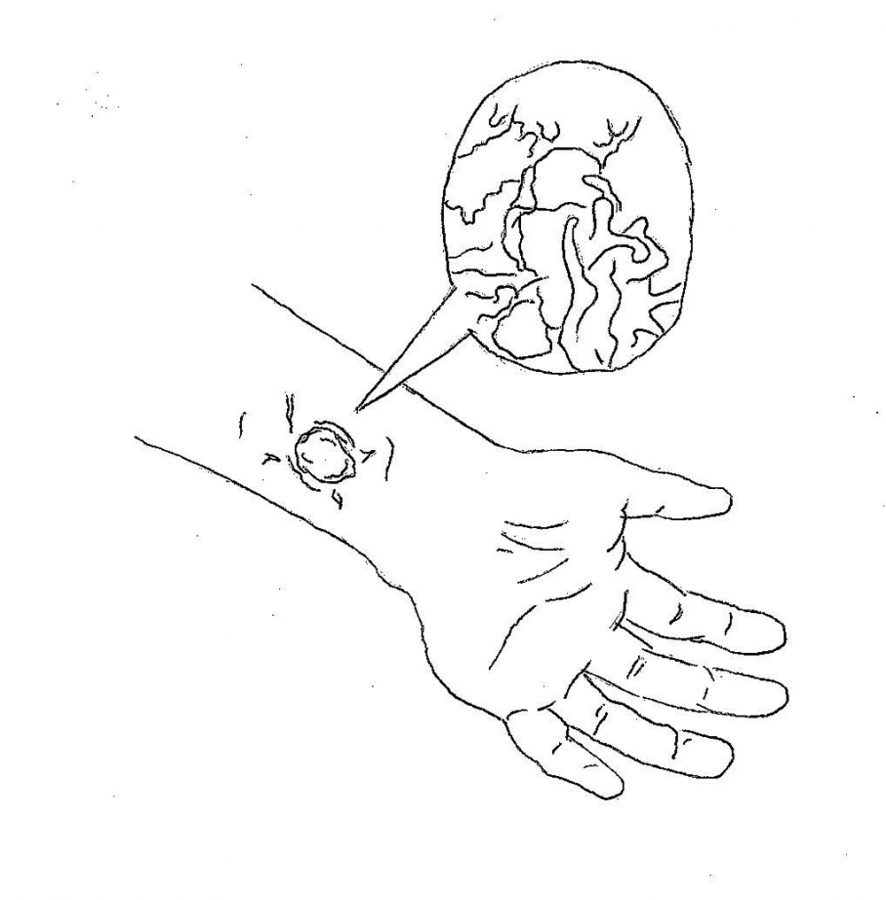MRSA season strikes
Illustration by Dietrich Sweeney
This case of MRSA would need a strong antibiotic and a strict schedule of taking it. “I can tell by looking at something if it needs to be seen by a doctor,” Nurse Leslie Perry said. “What you don’t want is the formation of a new infection that’s stronger because you didn’t use the antibiotics properly.”
December 12, 2016
As a former wrestler, I’ve had my share of “mat funk” – wrestlers’ endearing nickname for skin infections – such as impetigo and ringworm. With winter sports beginning, the risk of skin infections spreading is reaching a new high. However, skin infections are not limited to just athletes.
“[I got ringworm] from the mats in the wrestling room,” Caroline Kosco (’17) said. “I was laying on them and I got it on my neck behind my ear.”
Nurse Leslie Perry emphasizes that everyone is susceptible to skin infections, though she has noticed an association between sports and skin infections. “I see a couple skin infections a week,” Perry said. “Once we see one, we’ll see a couple more, especially during wrestling.”
While everyone is at risk for a skin infection, certain activities, especially contact sports, make infection more likely. “Infections don’t spread on walls and floors, it’s usually on things like mats,” Perry said. “What people get them from are things like weight lifting equipment. It’s often not the mats so much as the direct contact in wrestling.”
Skin infections are a common occurrence for athletes, and are usually easily treated. Wrestler Blake Walter (’18) has had impetigo and ringworm. “I saw a ring on my arm and I was like, ‘This is bad,’” Walter said. “The next year I saw [impetigo] on my arm and I was like, ‘This is also bad.’”
A topical cream takes care of most infections in a couple days, however, certain infections require specific products. “A lot of skin infections can be taken care of at home. It’s when you get something like ringworm that you need an antifungal, or an antibiotic for infections like impetigo,” Perry said.
Jack Amos (’19) had ringworm on his back from wrestling in the offseason. “I think I got it from wrestling at Loyola, but Lotrimin [an antifungal] took care of it fast.”
When left untreated, skin infections become a serious issue. Lexi Francis (’18) recalls a cheerleader getting Methicillin-resistant Staphylococcus aureus (MRSA) this past fall. “Right before one of our big competitions this girl got an infection on her knee and she had to go to Patient First,” Francis said. “They had to stick needles in it and drain it.”
The cheer team couldn’t compete in all their events because of the infection, and it also served as a wake-up call. “It was really scary and made us question how clean the wrestling mats are, and how clean our school is,” Francis said.
Varsity Wrestling Coach Brett Baier claims that skin infections don’t happen as much as they used to and are easy to prevent. “We wash the mats every day in between every practice,” Baier said, but he stressed that wrestlers have to do their part, too. “Take a shower everyday as soon as you get home, take all wrestling clothes home daily and wash them, don’t wear dirty clothes, and periodically wash headgear, knee pads, and wrestling shoes.”
Skin infections are a part of contact sports, and there is a calculated risk you take when you participate in one. It is important to maintain good hygiene habits and and treat infections early.





























